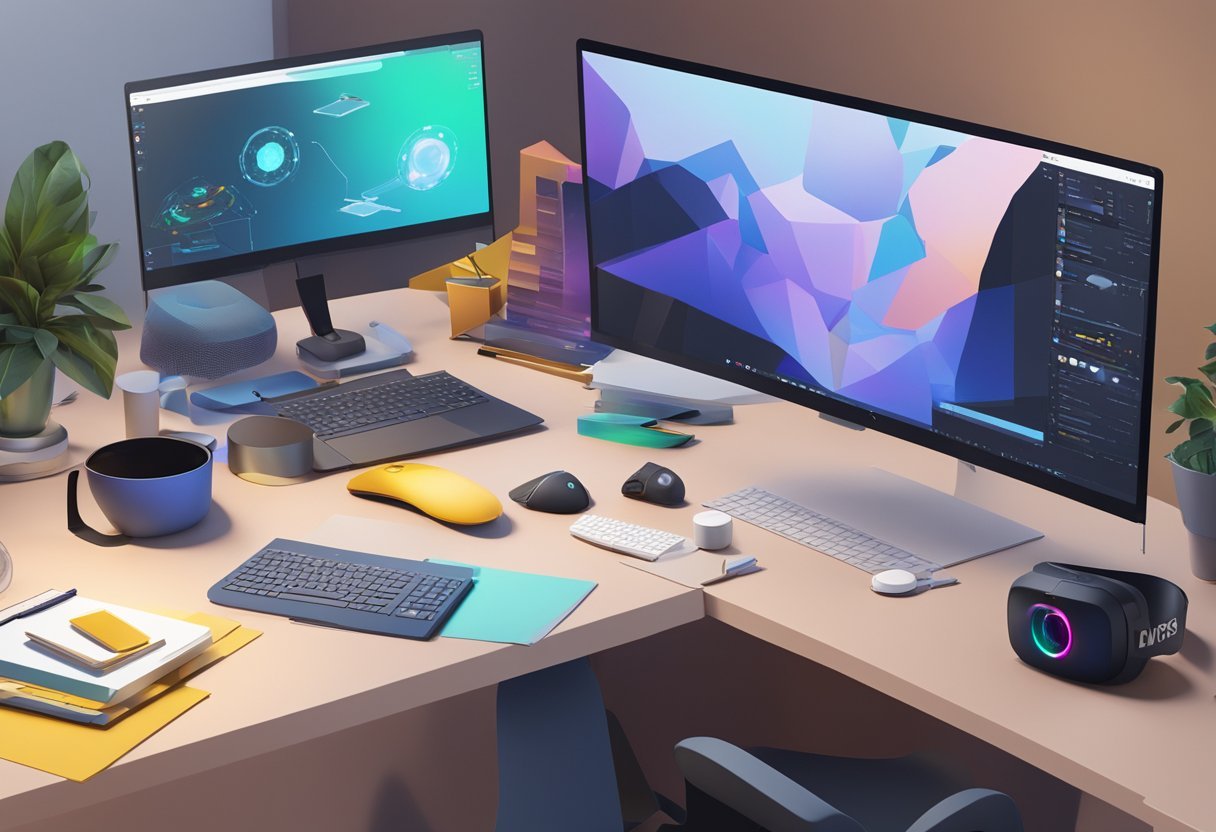Creating engaging experiences in the Metaverse is an essential part of successful virtual reality (VR) development. The best way to achieve this is through user-centric design, which focuses on understanding and responding to the needs and desires of users. By taking into account the context, environment, use cases, and goals of a given VR experience, developers can create immersive and interactive experiences that offer users a truly rewarding experience. In this article, I will show you how to create engaging Metaverse experiences. User-centric design using simple design principles and user feedback can help you develop experiences that capture the imagination, drive engagement, and inspire users to explore deeper.
Key Takeaways:
- Identifying users and understanding their needs is essential to creating engaging experiences in the Metaverse.
- User-centric design principles, such as context, environment, use cases, and goals should be taken into account when designing virtual reality experiences.
- Designers should consider how users interact with and use a given experience to create an optimal user experience.
- Content design plays an important role in conveying information intuitively and engagingly.
- Usability testing and user research can provide insight into how users perceive and interact with an experience.
- An iterative design process should be implemented to continually refine the experience based on user feedback.
What are User-Centric Designs?
User-centric design is a concept that puts the user at the center of the design process. This approach takes into account how users interact with, perceive, and use a given product or experience. Specifically, user-centric designs focus on:
1. Context:
Understanding the context in which a virtual world experience takes place can help developers create more engaging experiences tailored to a user’s needs.
2. Environment:
The environment in which a virtual experience takes place can have an impact on the overall experience, as users may be more or less engaged depending on the setting.
3. Use Cases:
Identifying and understanding use cases can help developers create experiences that meet the specific needs of different users.
4. Goals:
Understanding users’ goals and objectives can help developers ensure that their virtual space experiences are tailored to meet those needs.
5. User Interface/Interaction Design:
UX designers should consider how users interact with and use a given experience, as this will have an impact on the overall user experience and UX design in the metaverse.
6. Usability Testing:
It is important to test a given experience for usability issues before releasing it, as this will ensure that the experience is easy to use and understand.
7. User Research:
Developers should consider conducting user research to gain insight into how users perceive and record human-computer interaction with a given experience.
8. Content Design:
Content design is an important part of creating engaging experiences in virtual worlds, as it helps to convey information intuitively and engagingly.
9. Iterative Design:
Iterative design is a process that involves testing, refining, and improving an immersive experience in virtual spaces over time based on feedback from users. This ensures that the experience continually evolves to meet the needs of users.
How to Create Engaging Metaverse Experiences Using User-Centric Designs
Identify users
Identifying the target audience for an experience is key to creating an effective design. Developers should consider who will be using the experience and what their needs and goals are to tailor it accordingly.
Understand context
Understanding the context in which a VR experience takes place can inform design decisions and help developers create more engaging experiences tailored to individual users’ needs.
Analyze environment
Analyzing the physical environment of a given experience is important for creating realistic and immersive scenarios. Developers should consider factors such as lighting, sound, and visuals when designing for VR.
Define use cases
Developers should define use cases before creating their experiences to ensure that they are tailored to specific user needs. This will help them create an experience that is optimized for the target audience.
Identify goals
Understanding users’ goals and objectives is key to creating an experience tailored to their needs. This will ensure that the experience meets users’ expectations and helps them accomplish their objectives.
Design interface/interaction
Developers should consider how users interact with and use a given experience, as this will have an impact on the overall user experience. Careful consideration of navigation, controls, graphics, and sound should all be taken into account.
Design content
Content design is an important part of creating engaging experiences, as it helps to convey information intuitively and engagingly. Developers should consider how users will interact with the content to maximize engagement.
Test usability
Usability testing allows developers to identify potential issues before a given experience is released. This should be done throughout the development process to ensure that any problems are identified and resolved before launch.
Conduct user research
Developers should consider conducting user research to gain insight into how users perceive and interact with a given experience. This information can then be used to refine the design, making it more engaging for users.
User-Centric Design Techniques in the Metaverse
In addition to the principles outlined above, there are several user-centric design techniques that developers can use to create engaging Metaverse experiences. These include:
User Stories
User stories help developers understand and visualize how users interact with and experience an application or product.
Prototyping
Prototyping is the process of creating a working prototype of a given experience to test its usability and functionality.
This can be done through virtual reality (VR) platforms such as Unity or Unreal Engine, which allow developers to quickly create and iterate on their ideas.
User Testing
User testing allows developers to gain user feedback about a given virtual environment experience. Through user testing, developers can identify areas of improvement and refine their design accordingly.
Data Analysis
Analyzing data collected from user interactions with an experience can help developers understand how users interact with it. This information can then be used to inform the design and improve user experiences.
Accessibility
Ensuring that a VR interactive environment experience is accessible to all users is important for creating engaging experiences. This includes considering factors such as color contrast, font size, and interactivity.
Gamification
Gamification can help to increase user engagement by adding elements of competition or reward to an experience.
This can be used to motivate users and encourage them to explore virtual events more deeply than in the physical world.
Personalization
Personalizing an experience for individual users can help to create a more immersive and engaging experience.
This involves using data collected from users to tailor content, experiences, and interactions to each user’s interests and preferences.
Immersion
Immersive experiences are those that make users feel as if they are part of the experience. This can be achieved through immersive technologies and techniques such as sound design, visuals, and haptic feedback.
User-Centric Design Apps for Metaverse
Unity
Unity is a powerful game engine for creating interactive 3D environments. It allows developers to quickly create and iterate on their ideas, making it ideal for prototyping.
Unreal Engine
Unreal Engine is a game engine developed by Epic Games that offers a wide range of features and tools for creating immersive VR experiences. It also supports multi-user collaboration, making it ideal for team development.
Google Tilt Brush
Google Tilt Brush is an intuitive app that allows users to quickly and easily create 3D art in VR. It is an ideal tool for creating engaging experiences and adding a sense of immersion to any project.
Oculus Medium
Oculus Medium is a sculpting tool that allows users to quickly and easily create 3D objects using simple gesture controls. This makes it perfect for prototyping designs, as well as creating immersive content.
Quill
Quill is a VR painting tool developed by Oculus Story Studio. It allows users to quickly and easily create 2D or 3D illustrations in VR, making it an ideal tool for developing artistic designs.
Gravity Sketch
Gravity Sketch is a powerful design tool that allows users to draw and sculpt objects in 3D. Its easy-to-use interface and powerful features make it an ideal tool for creating engaging experiences in VR.
Codebender
Codebender is a coding environment that allows developers to quickly and easily write, test, and debug code in VR. This makes it perfect for creating interactive and immersive experiences.
High Fidelity
High Fidelity is a platform for creating collaborative virtual environments. It offers a wide range of tools and features for creating immersive and engaging experiences, as well as support for multi-user collaboration.
Motive
Motive is a motion capture tool that allows developers to quickly and easily capture user movements in VR. This makes it an ideal tool for creating realistic and immersive experiences.
Bottom Line
Creating engaging and immersive Metaverse experiences is essential for creating successful user-centric designs.
Developers need to take into account the needs of their users, analyze their environment, define use cases, identify goals, design interfaces, and interactions, create content, test usability, and conduct user research to create effective designs tailored to each user.
In addition, there are a variety of user-centric design tools available for creating VR experiences, such as Unity, Unreal Engine, Google Tilt Brush, Oculus Medium, Quill, Gravity Sketch, Codebender, High Fidelity, and Motive.
In the early stages of the metaverse, engaging and user-centric designs will be the key to success.
Now you know how to create engaging Metaverse experiences, user-centric design is essential for staying ahead of the competition.
With the right tools and processes, you can create experiences that are tailored to your users’ needs and goals, and engage them in a meaningful and immersive way.




